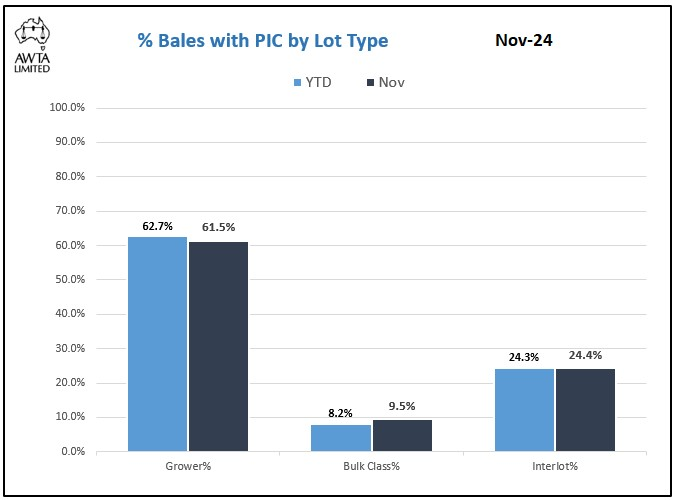
The Australian Wool Traceability Hub Gains Momentum
- 2024年12月02日, 星期一
The Australian Wool Traceability Hub (AWTH) continues to make significant strides in enhancing the wool industry's capability to respond effectively and quickly to an Emergency Animal Disease (EAD) outbreak. With a strong focus on increasing industry participation, the Hub is moving closer to its goal of providing comprehensive traceability across the domestic wool supply chain. This update highlights the progress in Property Identification Code (PIC) adoption, the evolving lot composition and industry-driven efforts to encourage greater engagement.
Industry Initiatives for increasing PIC Declaration
The state based PIC adoption rates reflect their respective stakeholder engagement, but increased uptake is needed across the country to reach the required >90% objective.

Recognizing the critical role of PICs, the industry has ramped up efforts to drive voluntary compliance and engagement. These initiatives include:
- Enhanced Communication and Education:
Targeted campaigns, including recent stakeholder meetings in the Melbourne, Sydney and Fremantle selling centres, webinars and resources available on AWTH’s website, are educating industry on the need to increase declaration rates. To date nearly 50% of all Wool Brokers and 30% of Wool Buyers/Private dealers have subscribed to the AWTH since its launch on July 29th. This is an impressive achievement in just 3 months but the challenge still remains to increase industry participation to 100% by the start of the next selling season.
A recording of the Sydney meeting is available here: https://www.youtube.com/live/0xSe3SZoThU?si=lrw6EpdtuSh0Q4Q6
- Consideration of Self-Regulated Mandating:
There is wide and growing industry support for a proposal that, in the first instance, declaring a PIC to the test house could become a requirement for the issue of IWTO test certificates for Grower and Interlot wool types. As such AWTA would require that a PIC be provided in order to issue the test certificate. The PIC would be held in the AWTA testing database and stored in accordance with industry agreements.
The likely earliest adoption of this proposal for commercial sale lots would be 1 July 2025.
- Improved Functionality with the AWTH:
Additionally, the AWTH platform will soon feature new user-friendly analytic tools for subscribers to monitor their own PIC declaration rates and identify lots that have PIC omitted. These tools will include real-time graphs that show their month-by-month PIC declaration rates alongside the overall state and national figures. This will be supplemented with a table that displays the number of sale lots updated in the AWTH each day and the respective PIC declaration rates. This data is provided confidentially to each subscriber in isolation and is not shared with any other businesses.
Steady Progress in PIC Adoption
Since its launch, the AWTH has seen a steady increase in the adoption of the Property Identification Code (PIC). Currently, the national PIC adoption rate stands at an impressive 70%, a marked improvement from just 50% earlier this year. This growth reflects the commitment of stakeholders across the supply chain, including growers, brokers, and exporters. However, to adequately safeguard the industry against potential EAD outbreaks, the AWTH is targeting an adoption rate exceeding 90% by July 2025.

PICs are essential for linking wool bales to their origins, ensuring rapid response capabilities in biosecurity emergencies and strengthening Australia’s reputation for high-quality wool with verified provenance. Stakeholders are encouraged to maintain this momentum and help achieve the upcoming milestone.
Lot Composition: A Snapshot
The composition of wool lots entering the supply chain through the AWTH is evolving. Currently for the 2024/35 season, grower lots represent the majority, accounting for approximately 88% of all sale lots tested. Interlots (1%) and Bulk Classed lots (11%) represent the remainder. Conversely, the respective PIC declaration rates for each lot type is shown below.

This distribution underscores the challenges in data acquisition and the need for robust traceability systems to capture data across all lot types while supporting diverse industry operations, especially within both presale and dealer Bulk Class & rehandling. The >90% target rate for July 2025 represents the sum of all Grower lots and Interlots, in recognition of the existing availability of grower’s PIC data for these lots types in Sellers’ systems. However, it has been acknowledged that PIC data is not as readily available for Bulk Classed lots. Discussions are ongoing as to how best to provide PICs for Bulk Classed wools in the AWTH EAD platform.
Building Toward a Resilient Future
The collective efforts of the AWTH and its stakeholders reinforce Australia's position as a global leader in wool traceability. With an anticipated 90% traceability rate before mid-2025, the Hub will be well positioned to support the industry during EAD scenarios, while also meeting growing consumer and market demands for sustainable and traceable products.
Monthly statistics on PIC declaration rates are published on the AWTA’s website:
https://www.awtawooltesting.com.au/index.php/en/statistics/declaration-rates
For more information about the AWTH and other resources, visit awth.com.au or contact AWTH Support at [email protected] .


